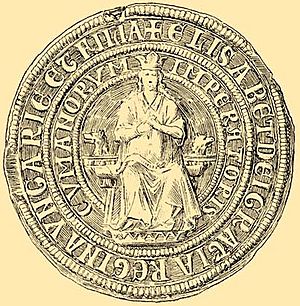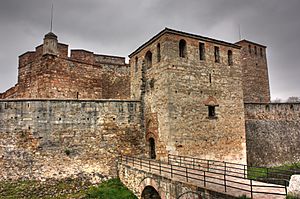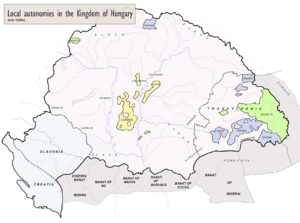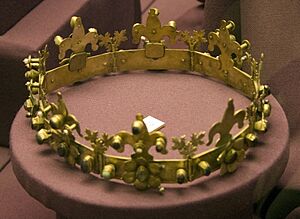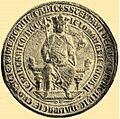Stephen V of Hungary facts for kids
Quick facts for kids Stephen V |
|
|---|---|
| Duke of Slavonia, Duke of Transylvania | |

Stephen's royal seal
|
|
| King of Hungary and Croatia | |
| Reign | 3 May 1270 – 6 August 1272 used the "junior king" as ruling title from 5 December 1262 |
| Coronation | 1246 (junior king) 17 May 1270, Székesfehérvár |
| Predecessor | Béla IV |
| Successor | Ladislaus IV |
| Duke of Styria | |
| Reign | 1258–1260 |
| Predecessor | Béla |
| Successor | Ottokar V |
| Born | Before 18 October 1239 |
| Died | 6 August 1272 (aged 32–33) Csepel Island, Kingdom of Hungary |
| Burial | Monastery of the Blessed Virgin on Rabbits' Island (now Margaret Island in Budapest) |
| Spouse |
Elizabeth the Cuman
(m. 1253) |
| Issue |
|
| Dynasty | Árpád dynasty |
| Father | Béla IV of Hungary |
| Mother | Maria Laskarina |
| Religion | Roman Catholic |
Stephen V (Hungarian: V. István, Croatian: Stjepan V., Slovak: Štefan V.) was a king who ruled Hungary and Croatia from 1270 to 1272. He was also the Duke of Styria for a short time, from 1258 to 1260. Stephen was the oldest son of King Béla IV and Maria Laskarina.
When Stephen was just six years old, his father, King Béla, had him crowned as a "junior king." He was also made the Duke of Slavonia. As a child, Stephen married Elizabeth. She was the daughter of a leader of the Cumans, a group of people his father had allowed to settle in Hungary.
In 1257, King Béla made Stephen the Duke of Transylvania. A year later, in 1258, he became the Duke of Styria. However, the local nobles in Styria did not like his rule. With help from King Ottokar II of Bohemia, they rebelled and forced Stephen's soldiers out of Styria. After Stephen and his father lost a big battle against Ottokar II in 1260, Stephen left Styria and went back to Transylvania.
Stephen later made his father give him all the lands east of the Danube River. He then started using the title "junior king" in 1262. A few years later, a civil war broke out between Stephen and his father. Stephen believed his father was trying to prevent him from becoming the next king. They made a peace agreement in 1266, but they never fully trusted each other again.
When his father died on May 3, 1270, Stephen became king without any problems. However, his sister Anna and his father's closest advisors fled to Bohemia. King Ottokar II invaded Hungary in the spring of 1271, but Stephen defeated him. The next summer, a rebellious lord captured Stephen's son, Ladislaus. Soon after, Stephen became sick and died unexpectedly on August 6, 1272.
Contents
Early Life (1239–1245)
Stephen was born in 1239. He was the eighth child and the first son of King Béla IV of Hungary and his wife, Maria Laskarina. Maria was the daughter of Theodore I Lascaris, who was the Emperor of Nicaea.
On October 18, Stephen was baptized by Archbishop Robert of Esztergom. He was named after Saint Stephen, who was the first King of Hungary. From the moment he was born, Stephen was the heir apparent, meaning he was expected to become king after his father.
In April 1241, the Mongols attacked Hungary and defeated the royal army. King Béla and his family, including young Stephen, had to flee to Zagreb. In February 1242, the Mongols crossed the frozen Danube River. The royal family then had to escape even further, to the well-protected town of Trogir in Dalmatia. Luckily, the Mongols unexpectedly left Hungary in March, and the King and his family could return home.
Becoming Junior King
Duke of Slavonia (1245–1257)
In 1246, a royal document mentioned Stephen as "King, and Duke of Slavonia." This means that in the previous year, his father, King Béla, had him crowned as a "junior king." He was also given control of the lands between the Dráva River and the Adriatic Sea. These lands included Croatia, Dalmatia, and Slavonia.
Since Stephen was only seven years old, these areas were managed by royal governors called bans.
In the late 1240s, King Béla IV wrote a letter to Pope Innocent IV. He mentioned that his son had married a Cuman girl. Her name was Elizabeth, and she was the daughter of a Cuman leader. King Béla had invited the Cumans to settle in the plains along the Tisza River. Elizabeth was baptized, and ten Cuman leaders were present. They took their traditional oath by cutting a dog in half with a sword.
Duke of Transylvania and Styria (1257–1260)
In 1257, Stephen became an adult. His father then made him the Duke of Transylvania. Stephen's time as Duke of Transylvania was short. In 1258, his father moved him to Styria. Styria had been taken over by Hungary in 1254. However, the local lords there rebelled and kicked out King Béla IV's governor.
Stephen and his father worked together to invade Styria and stop the rebels. Stephen also received two nearby counties in Hungary from his father. In the spring of 1259, he led a raid into Carinthia. This was to get back at Duke Ulrich III of Carinthia for supporting the Styrian rebels.
Stephen's rule in Styria remained unpopular. With help from King Ottokar II of Bohemia, the local lords rebelled again. Stephen could only hold onto one town, Pettau (now Ptuj, Slovenia), and its surrounding area. On June 25, 1260, Stephen crossed the Morava River to invade Ottokar's lands. His army, made up of Székely, Romanian, and Cuman soldiers, defeated an Austrian army.
However, in the main battle, the Battle of Kressenbrunn on July 12, Stephen and his father's combined army was defeated. This happened mostly because King Béla's main forces arrived late. Stephen, who was leading the first group of soldiers, barely escaped the battle. A peace treaty, the Peace of Vienna, was signed in March 1261. This treaty ended the fighting between Hungary and Bohemia. King Béla IV had to give up Styria to Ottokar II.
Conflicts and Civil War (1260–1270)
After August 20, 1260, Stephen returned to Transylvania and began ruling it for a second time. In 1261, he and his father together invaded Bulgaria and captured Vidin. His father went back to Hungary, but Stephen continued the campaign alone. He attacked Lom on the Danube River and went as far as Tirnovo. He was chasing Tsar Constantine Tikh of Bulgaria, but the Tsar managed to avoid fighting. Stephen pulled his troops out of Bulgaria by the end of the year.
Stephen's relationship with King Béla IV got worse in the early 1260s. Stephen's documents show he was worried his father might take away his right to be king. He also accused some powerful nobles of turning his father against him. Stephen's documents also show that he was giving away lands in areas outside Transylvania.
In the autumn, the archbishops of Esztergom and Kalocsa tried to help settle the disputes between the two kings' supporters. A peace treaty, the Peace of Pressburg, was made around November 25. King Béla IV and his son divided the country. Stephen received all the lands east of the Danube River. When he confirmed the treaty on December 5, Stephen also promised not to invade Slavonia. This land had been given to his younger brother, Béla, by their father. At this time, Stephen called himself "Junior King, Duke of Transylvania and Lord of the Cumans."
In 1263, a Bulgarian nobleman named Jacob Svetoslav asked Stephen for help. His lands, south of Vidin, had been taken over by Byzantine soldiers. Stephen sent soldiers to Bulgaria. They defeated the Byzantines and drove them out. Stephen then gave Vidin to Jacob Svetoslav, who agreed to be under Stephen's rule.
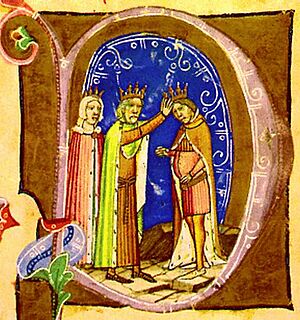
The peace between Stephen and his father did not last long. Stephen took over the lands of his mother and sister, Anna. These lands were in his part of the country. Sometime after the autumn of 1264, King Béla IV's army, led by Anna, crossed the Danube. They attacked and took Sárospatak and captured Stephen's wife and children.
A powerful leader named Ladislaus Kán turned against Stephen. He led an army of Cuman warriors into Transylvania. Stephen defeated him at the fort of Déva (now Deva, Romania). Then, King Béla's chief judge, Lawrence, arrived with a new army. He forced Stephen to retreat to Feketehalom (now Codlea, Romania). Lawrence's army surrounded the fortress, but Stephen's supporters rescued it. Stephen then launched his own attack and forced his father's army to retreat. He won a major victory over his father's army at the Battle of Isaszeg in March 1265.
The two archbishops again helped to make peace between father and son. This new agreement confirmed the 1262 division of the country. Béla and Stephen signed the peace treaty on March 23, 1266. This happened at the Convent of the Blessed Virgin on the Rabbits' Island (now Margaret Island in Budapest).
During the civil war in Hungary, Stephen's vassal, Jacob Svetoslav, switched his loyalty to Tsar Constantine Tikh of Bulgaria. In the summer of 1266, Stephen invaded Bulgaria. He captured Vidin, Pleven, and other forts. He defeated the Bulgarians in five battles. Jacob Svetoslav again agreed to be under Stephen's rule and was put back in charge of Vidin. From then on, Stephen called himself "King of Bulgaria" in his official documents.
In 1267, Béla and Stephen together confirmed the rights of the "royal servants," who were later known as noblemen. In 1269, Stephen made an important alliance with King Charles I of Sicily. Stephen's son, Ladislaus, married Charles's daughter, Elisabeth. Also, Charles's son, Charles, married Stephen's daughter, Mary. This strengthened Stephen's position with other countries.
However, trust was never fully restored between Béla and Stephen. On his deathbed, the old King asked King Ottokar II of Bohemia to protect his daughter Anna and his supporters after he died.
Becoming King (1270–1272)
King Béla IV died on May 3, 1270. His daughter, Anna, took the royal treasury and fled to Bohemia. Some of Béla's closest advisors also followed her. They handed over their castles along the western borders to Ottokar II. Instead of leaving Hungary, another noble, Nicholas Hahót, put soldiers in his fort and raided nearby villages.
Stephen chose his own supporters for the most important jobs. For example, Joachim Gutkeled became the Ban of Slavonia, and Matthew Csák became the Voivode of Transylvania. Stephen gave a county to Archbishop Philip, who crowned him king in Esztergom on or after May 17.
A Polish writer, Jan Długosz, wrote that Stephen went on a trip to Kraków to visit the tomb of St. Stanisław. He also visited his brother-in-law, Boleslaw the Chaste, the Duke of Kraków, in late August. The two kings renewed their old alliance. They agreed to have the same friends and enemies. Stephen also met Ottokar II on an island in the Danube River near Pressburg (now Bratislava, Slovakia), but they only agreed to a temporary truce.
Around December 21, Stephen led a raid into Austria. In April 1271, King Ottokar invaded the lands north of the Danube. He captured several fortresses. Ottokar defeated Stephen in battles in May, but Stephen won the most important battle on the Rábca River on May 21. Ottokar then left Hungary, and Stephen chased his troops all the way to Vienna.
The two kings' representatives reached an agreement in Pressburg on July 2. Stephen promised not to help Ottokar's enemies in Carinthia. Ottokar gave up the castles he and his supporters held in Hungary. The Hungarians soon took back their castles along the western border.
Stephen's saintly sister, Margaret, died on January 18, 1270. According to her Life story, Stephen was there when the first miracle linked to her happened on the first anniversary of her death. Stephen actually started the process to make Margaret a saint in 1271.
In the same year, Stephen gave special town rights to the people of Győr. He also confirmed the freedoms of the Saxon people in the Szepesség region (now Spiš, Slovakia). This helped their community grow. On the other hand, Stephen protected the rights of the Archbishop of Esztergom. He stopped some nobles from trying to avoid their duties to the archbishop.
In the summer of 1272, a powerful noble named Joachim Gutkeled kidnapped Stephen's ten-year-old son and heir, Ladislaus. He imprisoned Ladislaus in the castle of Koprivnica. Stephen surrounded the fortress but could not capture it. Stephen then became sick and was taken to Csepel Island. He died on August 6, 1272. Stephen was buried near his sister Margaret's tomb, in the Monastery of the Blessed Virgin on Rabbits' Island.
Family Life
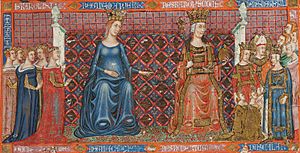
Stephen's wife, Elizabeth, was born around 1239. A document from her father-in-law, King Béla IV, mentions a Cuman leader named Seyhan as his relative. This suggests that Seyhan was Elizabeth's father.
Stephen and Elizabeth's first child, Catherine, was born around 1256. She married Stephen Dragutin, the older son of King Stephen Uroš I of Serbia, around 1268.
Their second daughter, Mary, was born around 1257. She married the future Charles II of Naples in 1270. Their grandson, Charles Robert, became King of Hungary in the early 1300s.
Stephen had another daughter (whose name is not given) who married Despot Jacob Svetoslav. His third (or fourth) daughter, Elizabeth, was born around 1260. She became a nun in the Monastery of the Blessed Virgin on Rabbits' Island. In 1277, she became the leader of the nuns. However, her brother, Ladislaus, kidnapped her and married her to a Czech noble in 1288.
Stephen's youngest daughter, Anna, was born around 1260. She married Andronikos Palaiologos, the son and heir of the Byzantine Emperor, Michael VIII.
Stephen's first son, Ladislaus IV, was born in 1262. He became king after his father died in 1272. Stephen's youngest child, Andrew, was born in 1268 and died when he was 10 years old.
Images for kids
See also
 In Spanish: Esteban V de Hungría para niños
In Spanish: Esteban V de Hungría para niños


